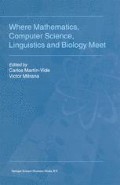Abstract
Until now, there have not been many attempts at using DNA strands as the technological base for evolutionary computing. This paper tries to prove that such a computing paradigm can be achieved using DNA strands and also that it seems to be the most appropriate computing paradigm when computing with DNA strands. Classical genetic algorithm operations are translated into DNA strands and DNA operations in order to implement them. This new approach will solve the inconvenience of having great amounts of DNA strands if a NP problem must be solved.
Access this chapter
Tax calculation will be finalised at checkout
Purchases are for personal use only
Preview
Unable to display preview. Download preview PDF.
References
Beaver, D. (1996), Universality and Complexity of Molecular Computation, in Proceedings of the 28th ACM Annual Symposium on the Theory of Computing (STOC).
Boneh, D.; C. Dunworth & J. Sgall (1996), On the Computational Power of DNA, Discrete Applied Mathematics, 71.1-3: 79–94.
Goldberg, D.E. (1989), Genetic Algorithms in Search, Optimization and Machine Learning, Addison-Wesley, Reading, Mass.
Head, T. (1987), Formal language theory and DNA: an analysis of the generative capacity of specific recombinant behaviors, Bulletin of Mathematical Biology, 49: 737–759.
Lipton, R.J (1995), DNA solution of hard combinatorial problems, Science, 268: 542–545.
Păun, Gh. (1996), Five (plus two) universal DNA computing models based on the splicing operation, in Proceedings of the Second Annual DNA Computing Workshop, Princeton.
Rodrigo, J.; A. Rodríguez-Patón; J. Castellanos & S. Leiva (1998), Molecular Computation for Genetic Algorithms, in Rough Sets and Current Trends in Computing, Warsaw.
Sambrook, J.; E.F. Fritsch & T. Maniatis (1989), Molecular Cloning: A Laboratory Manual, 2nd ed. Cold Spring Harbor, New York.
Yokomori, T.; S. Kobayashi & C. Ferretti (1995), On the power of circular splicing systems and DNA computability, Report CSIM 95-01, University of Electro-Communications, Chofu, Tokyo.
Author information
Authors and Affiliations
Editor information
Editors and Affiliations
Rights and permissions
Copyright information
© 2001 Springer Science+Business Media Dordrecht
About this chapter
Cite this chapter
Rodrigo, J., Castellanos, J., Arroyo, F., Mingo, L.F. (2001). Is Evolutionary Computation Using DNA Strands Feasible?. In: Martín-Vide, C., Mitrana, V. (eds) Where Mathematics, Computer Science, Linguistics and Biology Meet. Springer, Dordrecht. https://doi.org/10.1007/978-94-015-9634-3_37
Download citation
DOI: https://doi.org/10.1007/978-94-015-9634-3_37
Publisher Name: Springer, Dordrecht
Print ISBN: 978-90-481-5607-8
Online ISBN: 978-94-015-9634-3
eBook Packages: Springer Book Archive

